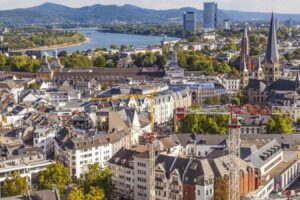TEXT: Sibel BÜLAY
The history of hydrogen goes all the way back to the 16th century, where it was first observed in 1520. In 1700 it was found to be explosive. Today, in our search for GHG-free energy alternatives, green hydrogen is emerging as an important player in sustainable mobility and as a means of decarbonizing industry. Research and development on all facets of hydrogen is on-going. Cars and buses are on the streets of cities throughout the world. And the Hydrogen Route already connects the Basque Country to Catalonia, along with its infrastructure of hydrogen fueling stations. Collaborative projects are everywhere from the production of hydrogen, all along the value chain, from transport to storage to distribution. The Auvergne Rhône Alpes Region is already building an intra-regional hydrogen pipeline; and plans are in place to build a pipeline to Germany.
For me, this session at the Multilevel Action Pavilion was a reminder that replacing fossil fuels requires a broad set of solutions. There is no “one size fits all” when it comes to sources of energy. The energy mix of the future is going to be a local solution based on geography; the availability of natural resources; local know how; technology; economic and social considerations. (I know the list can be expanded.) Hydrogen is not only on the list of alternative fuels, it is already in play. The challenge is that you need (lots of) energy to produce hydrogen. Renewable energy sources such as wind and solar are being used to produce green hydrogen. (According to the Hydrogen Report presented at COP 27, there are many colors of hydrogen: white hydrogen, which is its natural form; grey hydrogen, produced from fossil fuels; black hydrogen produced from coal; blue hydrogen produced from natural gas; turquoise hydrogen produced from methane; and pink or red hydrogen produced from nuclear energy.)
The interest in hydrogen, as evidenced by this session, is global with speakers from S. America, Africa and Europe.
The sessions was moderated by Carles Llorens, Secretary General, ORU Fogar. The speaker list included:
- Mairi McAllanMSP, Minister for Environment and Land Reform, Scottish Government
- Rachid el Abdi, President of ORU Fogar and of the Regional Council of Rabat Salé Kénitra, Morocco
- Laurent Wauquiez, President of the AIRF and of the Auvergne Rhône Alpes Regional Council, France
- Iñigo Ansola Kareaga, Managing Director of Basque Energy Entity
- Ariel Scheffer, Superintendent of Environmental Management of ITAIPU Binational, Brazil
- Albert Ballbé, responsible for Hydrogen Strategy, Department of Business and Labour, Catalonia, Spain
- Gianna Elisa Berlingerio, Director of the
Department of Economic Development of Puglia Region, Italy
As a result of the war in Ukraine, we are face to face with a global energy crisis. Mairi McAllan says we are facing an energy trilemma: the need to balance costs; the need to reduce emissions; and the need to ensure energy security. But these cannot be addressed as a cost of living crisis and an energy security crisis. They must be addressed altogether, not separately. Addressing these as individual crises threatens to undermine the climate battle. There is an urgency across Europe to deploy renewables. And this challenge presents an opportunity that is just as great as the threats it poses. Gianna Elisa Berlingerio not only agreed with the trilemma concept, she said we are facing a “fourlemma” adding the need to protect our landscape and rationalize land use, citing agriculture as an example.
Hydrogen is an important factor in meeting the net zero target for each of the regions in this session. And since mobility is one of the principal sources of GHG emissions, it is also the sector in which hydrogen is already in play. Scotland is piloting a hydrogen bus fleet. I already mentioned Spain’s Hydrogen Route. The Auvergne Rhône Alpes Region is particularly vested in this area. They have partnered with several companies and banks to create a complete hydrogen mobility ecosystem, bringing together production, storage and distribution infrastructures.
Decarbonizing industry is also an important step in achieving the net zero target and is, therefore, an important driver of the transition to green hydrogen.
All the panelists spoke of collaboration being critical to the deployment of a hydrogen future. Development of the hydrogen global economy will require multilevel, coordinated action from subnational governments all the way up to the international community. All panelists spoke of the need for, and their involvement in, regional hubs.
- Scotland is co-leading a green hydrogen task force as part of the Under 2 coalition of the Net Zero futures policy forum.
- The Kingdom of Morocco is working on a regional initiative around the use of hydrogen In industry. They are also looking at the use of hydrogen in the heavy transport sector: trains, shipping, planes. Leaders in the hydrogen sector are of the opinion that green hydrogen could reposition the role that Africa plays in the world economy with Africa becoming one of the powerhouses of renewable energy.
- Catalonia is a member of the Working Group on Hydrogen in the European Assembly of Regions.
- The Working Community of the Pyrenees, a Franco-Catalan partnership, is focusing on hydrogen for the next 2 years.
- Bari Polytechnic, in Puglia, is leading a team of 12 universities in Italy who are developing new energy scenarios, including hydrogen. An interdepartmental group is building a regional strategic vision on hydrogen. The document will be finalized within a few weeks, following the completion of the on-going public consultation.
- Basque Hydrogen Corridor Association is working to establish a hydrogen ecosystem with public private collaboration. 1st phase focus is on hydrogen production. The focus of phase 2, 2026-2030, will be developing the hydrogen infrastructure.
In addition to collaboration, cities and regions need to know where they are going. And to this end they have develop, or are in the process of developing plans and strategies.
- Scotland’s Hydrogen Action Plan planning to produce 25 gigawatts of renewable and low carbon hydrogen by 2045.
- The Basque Hydrogen Strategy is establishing guidelines to drive the creation of a hydrogen ecosystem which will include the production of hydrogen from renewable sources, and storage, transport and distribution infrastructures.
- Hydrogen Valley of Catalonia is a collaboration of companies, tech centers to promote collaborative projects. They are working on strategy, developing capacity and sharing knowledge with the Basque Country. They currently have 37 global initiatives on-going along hydrogen value chain.
- An interdepartmental group, based in Puglia, is building a regional strategic vision on hydrogen. The document will be finalized within a few weeks, following the completion of the on-going public consultation. Puglia is working with the national government, and other regional governments on a flagship project: establishing a Hydrogen
- The Principle sectors of the economy in Parana State are agriculture and livestock; and biomass and bio methane are two important sources of renewable energy in the state, along with solar energy. The Parana State Sustainable Energy Program is working on the production of green hydrogen with biogas and bio methane.
According to Albert Ballbé, hydrogen is about air quality, climate change, the energy crisis. Hydrogen is something we have to work with. We need a broader strategy. There is interest not only in production, but along the entire value chain. The hydrogen market needs to be stimulated with incentives. Tools the city government has at hand are public procurement for innovation and taxing carbon. Today the cost of renewable energy is high and this can be a stimulator for green hydrogen projects.
In Puglia, Gianna Elisa Berlingerio said that more than 24000 enterprises have invested in green technology and products. Puglia is #1 in Italy for power generation from renewables and Puglia’s hydrogen strategy is being built on green hydrogen produced from solar and onshore and offshore wind energy. There is knowhow in the region; pilot projects are underway; and the region has a solid university and research system. Puglia is also participating in the European decarbonization goals, part of the EU Green Deal.
Laurent Wauquiez highlighted the importance of hydrogen in the mobility sector. The limited range, charging times and the fact that it doesn’t meet the needs of the trucking industry are some of the issues associated with electric vehicles. Hydrogen can be a solution to all of these issues. But it is best not to think of this as an either or issue. Rather, hydrogen fueled vehicles should be seen as a complement to electric vehicles. Wauquiez also spoke of the vast need for R&D, stressing that we are just at the beginning of the hydrogen transition.
We may be at the beginning of the hydrogen tradition, but clearly there is a lot of ambition around it both in the public and private sectors. And, beyond ambition, there is a lot happening all over the world.




